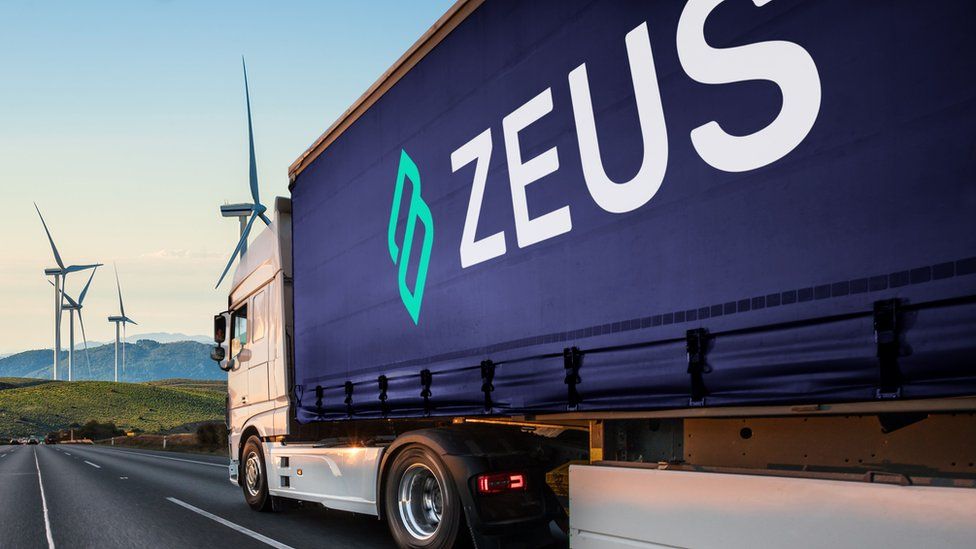Why empty lorries are a problem and how to fix it

Drive down almost any road in the UK and take a look at the lorries. Ever wonder what’s inside? Food, fuel, furniture?
Actually, there’s a good chance it could be nothing at all. One in three lorries on Britain’s roads is driving empty.
“You can tell if a truck is empty by seeing whether its fourth set of wheels is touching the ground,” says Clemente Theotokis, co-founder of digital freight management firm Zeus.
Haulage vehicles, he says, are often able to lift a set of wheels when they are running partly loaded or empty.
In the UK, heavy goods vehicles (HGVs) travel empty for over three billion miles every year, according to the Department for Transport (DfT). This is the equivalent of driving to the moon and back 6,500 times – or more than 5,000 years of driving.
These empty miles incur costs without generating income, which is particularly painful in a period of high fuel prices. And, with road freight accounting for 53% of the transport sector’s CO2 emissions within global trade-related transport, firms like Zeus are looking for ways to reduce unnecessary journeys, costs and emissions.
“Logistics is one of those fragmented, old school industries – lacking in technology for day-to-day operations,” says Mr Theotokis.
He says firms like Zeus could help hauliers coordinate their journeys – and share the load.
“Roughly 150,000 trucks run completely empty every single day,” he says. “The core reason for this is that the whole industry is still reliant on manual ways of working.”

So, back in 2020, Mr Theotokis and his friend Jai Kanwar created Zeus to connect hauliers straight away to local businesses in need of transportation. They now have 2,000 clients – who they promise to save “north of 10%” in running costs.
Zeus’s digital marketplace allows clients to see all available lorries – and everything is managed through a web app and driver mobile app, eliminating paperwork.
“For trucking companies, it’s hard to get recurring revenue throughout the year,” says Mr Theotokis. “One of the main reasons you see trucks running empty is lack of access to work.”
Hauliers can find both spot and contract work with Zeus and, adds Mr Theotokis, can reduce their empty runs by 30%.
But changing the mindset of an “extremely traditional industry” is a challenge, he says.
Jordan Shelvey, for one, is unconvinced. Ms Shelvey, director of Shelvey Haulage, has worked for her Essex-based family business since leaving school eight years ago.

“In reality, it could be a challenge for [digital] systems to allow for all the variables that can happen on a journey – delays, setbacks, accidents,” she says.
In fact, Shelvey Haulage doesn’t even have a website and finds word of mouth the best way to coordinate their work.
“We always stay in touch in with customers and make sure they’re happy,” she says.
However, there are signs that the road haulage industry is in the early phases of “disruptive change“. Electrification of vehicles is emerging and digitisation is on the rise.
“Globally, international volumes of freight transport are predicted to more than double by 2050,” says Dr Maja Piecyk, professor of logistics at Westminster University.
“We’ll be moving twice the amount of freight through already congested networks. Yes, we can improve the flow but we are not going to double the capacity – we’re not going to double the number of motorways. So, we need to address things like empty running.”

However, she warns, despite scope for improvement, many cases of empty running are unavoidable. An oil tanker can’t make a return journey carrying milk, for instance, and refrigerated food can’t be brought back at an ambient temperature.
“Plus there are structural imbalances,” she says. “For example, more freight goes into Scotland than comes out. The same happens with cities.”
There are also concerns that digitisation could have a negative impact on drivers. Experts warn of a “gig economy” that could put workers at risk of exploitation.
Chill-Chain addresses this by only working with already-established haulage companies.
“We’ve made sure the marketplace we operate won’t drive that kind of behaviour,” says Jack Fleming, founder of the digital freight management firm. “We have no self-employed contractors.”
Previously head of restaurant operations for Deliveroo, Mr Fleming was inspired by the digital capabilities of the online food delivery company – and saw its potential for improving road freight coordination.

“Deliveroo knows where a pizza is at all times, but people don’t know where their lorries are,” he says. “So instead of £10 worth of goods on the back of a moped, you’ve got £40,000 worth of goods in the back of a lorry – and the customers don’t know where they are, whether they’ve been picked up or when they’re going be delivered.”
In 2019, he launched Chill-Chain, software which connects shippers and haulage companies – allowing hauliers to fill otherwise empty vehicles. Plus, groups of manufacturers can collaborate, transporting two part-full loads together in a single lorry.
Collaboration between parcel carriers is rare because companies are usually competing with each other for business. This leads to “all going everywhere” – increasing traffic congestion, fuel consumption and vehicle emissions.
Conversely, consolidating deliveries is estimated to offer time, distance and emissions savings of about 60% over business-as-usual operation – all at a reduced cost.
Chill-Chain also enables manufacturers to view their entire road supply chain.
“They can suddenly see everything – all in one place,” says Mr Fleming.
Back in London at Zeus, Mr Theotokis says: “By becoming more automated the industry will improve – both from a trucker’s point of view and from a manufacturer’s point of view.”
